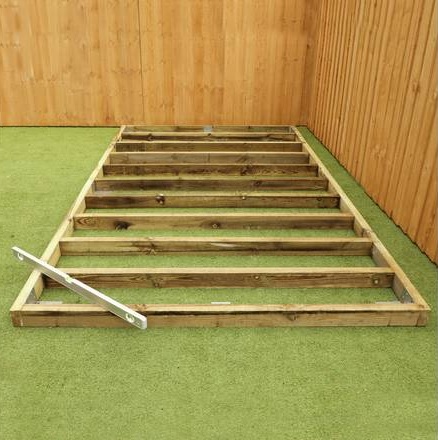Having good foundations is crucial for any shed. The other day, I was thinking, what is the best base to put a shed on?
After doing some research on the topic, I have found the best base to put a shed on is either a wooden frame, concrete or paving slabs.
Why does a shed need a base?
It’s really important that your shed has a solid foundation so a base is vital.
There are 3 main reasons why a shed needs a base:
- To make the ground level – It’s really important to have the ground level when setting up your shed so this is why having a base is such a good idea. When laying the base you can check to see if the ground is level with a spirit level.
- To support the weight of the shed – Another great reason why you need a base is because you need something to support the weight of the shed and everything in it. If you just put the shed on soil, then it will eventually sink.
- To allow air circulation below the shed – You don’t want the shed to rot, so this is another great reason to install a sturdy base.
Without a great base for your shed, you could set up your shed and it could be not level, it could sink or slope and could rot.
What types of shed bases are there?
There are 3 main types of shed bases
- Wooden Shed Bases – These are shed bases that are wooden. They are usually just wooden frames which are slightly higher than ground level. They usually have spikes on each corner to go into the soil. Make sure the wooden shed base is level before adding your shed on top.
- Concrete
- Paving Slabs
It’s essential that your shed has a dry and level foundation. If you try and assemble a shed on an unsound base, you run the risk of the screw holes connecting the wall panels not lining up correctly.
I found some really good wooden shed bases on this website here. They also have some really good other types of bases too.
Where should I build a base?
You may need to do some maintenance in the future on your shed or apply a wood treatment so don’t build a base too close to a fence or a tree.
Are you intending on running an electricity and/or water supply to the shed?
These are some things you may need to think about when positioning your shed.
How to build a base
So now we’ve worked out why it’s important to build a base and we’ve found an area to build the base and we know what type of base we are going to use, now it’s important to work out how to build it.
How to build a timber bearer base
Using pegs and string, mark out an area 2 inches larger each side than the shed size.
Measure the area diagonally across both sides to confirm your area is square and not slanted.
Remove any vegetation and dig out the area so it’s 2 inches deep. Once you have done this you can remove the pegs and string.
Within the dug out area, add about 1.5 inches of soil or gravel. Then use a rake to level it out. You may want to use a spirit level as well.
Lay the timber bearers across the gravel or soil. These should be spaced equally at intervals of between 400mm and 600mm.
Make sure that all the timber bearers are level. You can use a spirit level to do this.
Depending on the size of your shed, you will need different amounts of bearers.
- 6×4 garden building – 4 bearers at 1150mm (4ft) long
- 7×5 garden building – 4 bearers at 1450mm (5ft) long
- 8×6 garden building – 5 bearers at 1750mm (6ft) long
- 10×8 garden building – 6 bearers at 2350mm (8ft) long
Buy Shed Bases From Sheds.co.uk
How to build a concrete base
Using pegs and string, mark out an area 2 inches larger each side than the shed size.
Measure the area diagonally across both sides to confirm your area is square and not slanted.
Remove any vegetation and dig out the area so it’s 6 inches deep.
To contain the cement you will need to create a timber framework to line the edges. You need to ensure this is sitting flat so use a spirit level to check this. You can also use a rake and a spade to flatten out the surface.
Add 3 inches of hardcore and level off with sand.
Once you have done this you can remove the pegs and string.
You can now add the concrete. Spread evenly and level off. Cover with a sheet and allow the concrete to dry naturally.
When the concrete is set, it will be firm and dry.
How to build a paving slab base
Using pegs and string, mark out an area 2 inches larger each side than the shed size.
Measure the area diagonally across both sides to confirm your area is square and not slanted.
Remove any vegetation and dig out the area so it’s 2.5 inches deep.
Once you have done this you can remove the pegs and string.
In the dug out area, lay approx 1.5 inches of 1 part cement to 8 parts sand.
Level off with a rake and a spirit level.
Starting at a corner, lay the paving slabs and tap them with a rubber mallet. Continue until all the slabs have been laid.
Use a spirit level to ensure all the slabs are level.
Brush off any excess cement and sand mix.

